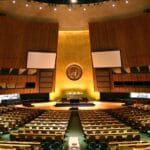Thinking creatively about the North Korean stalemate
By Hugh Gusterson | August 12, 2009
We all know the saying that you can’t be a little bit pregnant–either you are or you aren’t. According to Henry Kissinger, getting nuclear weapons is like getting pregnant. In a Washington Post op-ed published on Nagasaki Day, Kissinger wrote, “The root cause of our decade-old controversy with Pyongyang is that there is no middle ground between North Korea being a nuclear-weapons state and a state without nuclear weapons.”
This is quite simply wrong–so wrong that Kissinger’s statement suggests that another root cause of our decade-old controversy with Pyongyang may be an inability on the part of U.S. defense intellectuals to think creatively about the stalemate. Because being nuclear isn’t like being pregnant at all: One can think of a number of agreements with North Korea that might allow it to be a little bit nuclear.
There is more than one way of being nuclear and, in the emergent international system, stealthier and more virtual forms of nuclear weapons ownership are becoming more salient.”
Pyongyang is thought to have less than a dozen nuclear weapons. (By comparison, according to the March/April 2009 Nuclear Notebook, the United States has about 5,200 nuclear weapons, of which about half are operationally deployed, with yet another 4,000 nuclear weapons “retired” but not dismantled.) One could imagine an agreement whereby the North Koreans would keep their handful of starter nuclear weapons, but agree (under the strictest international safeguards) to forego the ability to make the plutonium or uranium they would need to make more weapons. That would leave them with a tiny, rudimentary nuclear stockpile (Model Ts in world of Lexuses) that would be frozen in that condition.
Alternatively, North Korea could give up the weapons it now possesses, but be allowed to stockpile plutonium that might be used to make nuclear weapons in the future. Pyongyang would forego finished, deployable weapons but maintain the ability (under strict international monitoring) to reconstitute such weapons at short notice as a hedge against potential future threats. This would allow the North Korean regime to have a sort of virtual bomb.
Or the North could be allowed to keep its weapons, but agree not to test the missiles that might carry them to foreign targets. That would give them the Bomb but not the standard means of threatening other countries with it.
It might even be possible to have some sort of arrangement, loosely modeled on the Chastelain agreement with the catholic and protestant paramilitaries in Northern Ireland, whereby some key component of North Korea’s nuclear weapons was stored separately, under some sort of third-party safeguard, so that the weapons couldn’t be constituted as fully functional without alerting that third party.
The official position of the U.S. government, even after two North Korean nuclear tests, is that Pyongyang must give up its nuclear weapons capability entirely. It is, I suppose, not entirely inconceivable that North Korea, having spent billions of dollars developing a nuclear deterrent, would agree to this in exchange for some extraordinary combination of generous international aid, diplomatic recognition, a formal end to the Korean War, and real security guarantees. Still, as David Sanger wrote in the New York Times the same day that Kissinger’s piece appeared in the Post, reporting on the fading prospects for rolling back North Korea’s nuclear capability, “Few of [President Barack] Obama’s aides, some of whom have wrestled with North Korea for decades, believe that the North will ever give up everything in its nuclear panoply.”
And with good reason. While there are countries that have given up their nuclear weapons, their situations were quite different from North Korea’s. South Africa dismantled its nuclear weapons capability because its white leaders wanted to ensure, in the last days of white minority rule, that they didn’t hand over the most powerful weapons in existence to black Africans. Ukraine, Belarus, and Kazakhstan gave up the nuclear weapons that fell in their laps when the Soviet Union disintegrated in 1991 because they lacked the infrastructure to sustain them and were offered handsome inducements by others to get rid of them.
By contrast, North Korea clearly has the technical infrastructure to maintain a small nuclear stockpile. Meanwhile its leaders–internationally isolated and insecure–see nuclear weapons as a way of protecting their country from foreign threats and maintaining their regime. In a situation where the U.S. government named them a charter member of the “axis of evil”; Washington made a provision for an attack on North Korea in its last Nuclear Posture Review; and pundits keep prattling on about the desirability of regime change in North Korea, why on earth would a rational North Korean leadership give up nuclear weapons, their ace on the hole?
While we shouldn’t give up on the goal of denuclearizing North Korea, we need to think in the short-term about creative ways of inducing North Korea to accept some sort of liminal status in between nuclear and nuclear-free. Such a status would hardly be unique. Until their 1998 nuclear tests, India and Pakistan inhabited a sort of nuclear twilight zone. And for decades, Israel has practiced a studied ambiguity about its nuclear weapons capability. In a different way, Japan has a sort of virtual nuclear weapons status: Everyone knows that Tokyo has the nuclear material and scientific expertise to build a nuclear weapon within a few months if it should so choose, and it can use international recognition of this fact to exert subtle pressure from time to time.
Some arms controllers might fear that this blurring of the line between nuclear haves and have-nots threatens the integrity of the Nuclear Non-Proliferation Treaty (NPT). However, it may be that allowing certain kinds of shadow nuclear capabilities keeps the basic international bargain underlying the NPT alive in a context where the established nuclear powers have ignored their legal obligation to denuclearize.
Kissinger learned to think about nuclear weapons in the context of the U.S.-Soviet rivalry where the declaratory bravado of nuclear testing evolved into a sort of international chest-pounding ritual of mutual intimidation. But there is more than one way of being nuclear and, in the emergent international system, stealthier and more virtual forms of nuclear weapons ownership are becoming more salient. We need diplomats, defense intellectuals, and arms control experts who, instead of seeing the world through the tired binaries of the Cold War, understand the dangers and possibilities of other ways of claiming nuclear power.
Together, we make the world safer.
The Bulletin elevates expert voices above the noise. But as an independent nonprofit organization, our operations depend on the support of readers like you. Help us continue to deliver quality journalism that holds leaders accountable. Your support of our work at any level is important. In return, we promise our coverage will be understandable, influential, vigilant, solution-oriented, and fair-minded. Together we can make a difference.
Topics: Columnists, Nuclear Weapons















